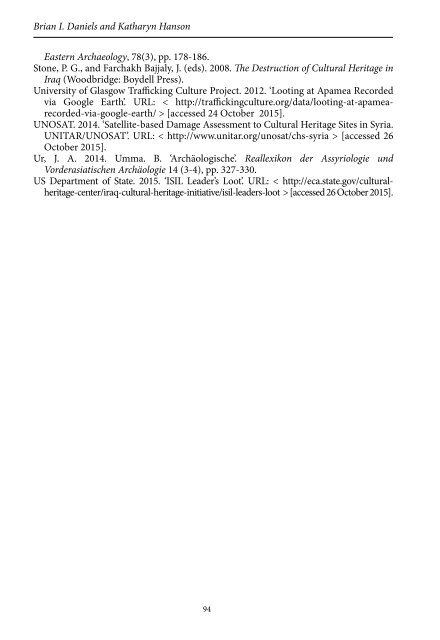Countering
Book_observatory_illicit_traffic_version%20issuu
Book_observatory_illicit_traffic_version%20issuu
Create successful ePaper yourself
Turn your PDF publications into a flip-book with our unique Google optimized e-Paper software.
Tess Davis<br />
The Lasting Impact of United States vs. Cambodian Sculpture<br />
On 28 February 2012, the New York Times revealed that Sotheby’s auction house in<br />
Manhattan was attempting to sell a thousand-year-old Khmer masterpiece for millions<br />
of dollars, despite evidence thieves had hacked the figure off at the ankles from a sacred<br />
Cambodian temple and trafficked it overseas in the chaos heralding the ‘Killing Fields’.<br />
The newspaper illustrated this front-page story with a photograph of the larger-than-life<br />
‘mythic Warrior’ as it appeared in the glossy pages of the sales catalogue. Another image<br />
showed its feet and pedestal – half a world away and still in situ – at the 10 th century ruins<br />
of Koh Ker, deep in the Cambodian jungle (Blumenthal and Mashberg 2012).<br />
The resulting scandal over the Koh Ker Warrior would eventually reveal a major<br />
antiquities trafficking network that stretched from the South East Asian Kingdom to<br />
the very heights of the global art market – implicating not only Sotheby’s, but some<br />
of the world’s top collectors, galleries, and museums. In doing so, it also launched an<br />
international – and ongoing – effort to bring home the plundered past of the Khmer<br />
people. Cambodia has triumphantly played David to the art market’s Goliath, joining<br />
the host of nations fighting to recover their looted and stolen art through public appeals<br />
and legal action.<br />
It is no wonder: while ancient sites have been pillaged throughout history, in recent<br />
decades, the illicit antiquities trade has become a lucrative and sweeping underground<br />
industry 1 . Far from being mere treasure hunting, experts warn this illicit trade is<br />
furthering crime and conflict around the world, funding brutal dictatorships, armed<br />
insurgents, and even jihadists like the so-called Islamic State of Iraq and Syria (ISIS). In<br />
February 2015, the United Nations Security Council indeed confirmed that ISIS, the Al-<br />
Nusrah Front, and al Qaeda are arming themselves through ‘the looting and smuggling<br />
of cultural heritage’ 2 . And a growing number of Western political leaders – including<br />
London’s Mayor Boris Johnson, a coalition of United States Congressmen, and US<br />
Secretary of State John Kerry – have likewise sounded the alarm (Johnson 2015).<br />
Four decades ago, the global hot spot was not Mesopotamia, but Indochina. During<br />
Cambodia’s bloody 1970-1998 war with the Khmer Rouge – as is the case today in Iraq<br />
and Syria – violence and plunder went hand-in-hand. The conflict triggered organized<br />
antiquities looting and trafficking, which in turn, helped to bankroll the fighting. Few<br />
of the country’s temples – not even the famous Angkor Wat – were spared from war<br />
profiteers. The fight for the Koh Ker Warrior revealed the inner workings of this illicit<br />
trade, and in the process, sent shockwaves through the art world. It led to a fundamental<br />
change, not only in how those in the market and museum community view Cambodian<br />
antiquities, but in how the Cambodian government and people do themselves. There<br />
appears to be no going back to the status quo that existed before. This paper therefore<br />
aims to revisit the case, evaluate its impact thus far, and reflect on the repercussions to<br />
come.<br />
United States vs. 10 th century Cambodian sandstone sculpture<br />
Cambodia’s art and archaeology has invaluable cultural, historic, and religious<br />
significance to the Khmer people. Since it attracts millions of tourists each year, this<br />
95


